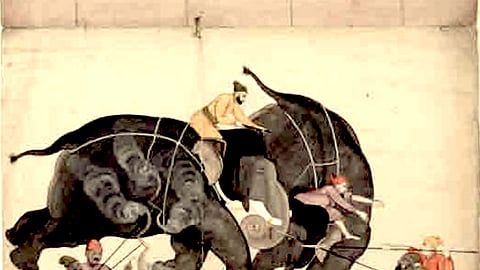- Commentary
- History Vignettes
- Notes on Culture
- Dispatches
- Podcasts
- Indian LanguagesIndian Languages
- Support

WHEN THE BLOODTHIRSTY MOB OF SHOE-SELLERS and their supporters reached the palace, Muhammad Shah was returning with his mother Qadsiya Begum from a visit to the Jafar Khan garden. The moment the mob saw him, they roared, Deen! Deen! Deen! Insaaf! Insaaf! A dumbstruck Muhammad Shah managed to pacify them and listened to their complaint. After this, Qamar-ud-din Khan the Wazir, was ordered to send a palace attendant to arrest the accused wherever he might be found.
When the palace attendant reached Sher Afkhan Khan’s bungalow, he was told to basically get lost. Broadly speaking, this was the first clear indication of Muhammad Shah’s utter powerlessness.
But the inflamed shoe-sellers would not relent. They went around Delhi, door-to-door, provoking every Muslim home to join their campaign to defend the Deen and express their loyalty to the Qaum. The magic pill that has historically elicited countless victories for Islam: Islam khatre me hai! Islam is in danger! Do your duty.
It worked like magic.
At the afternoon Namaaz, Jama Masjid, the assembly point, was overflowing with the Faithful. Its spacious precincts and its vast courtyard and its inner hall thronged with vengeance-seekers and would-be Islam-protectors. The charged-up horde jammed the praying space and the pulpit and the prayer itself was blockaded even as the clamour and confusion escalated each second.
Leading the rowdy and blood-baying gang was a motley assortment of imported Muslims: Arabs, Abyssinians, and Constantinople Turks. They had been freelance mercenaries brought into Hindustan by two Mughal military officers—Rumi Khan and Sayyad Arab Ali Khan—and had served in the artillery for some time. This mercenary import is a salient feature of all Muslim sultans who ruled Delhi and by itself, forms a separate folio in the blood-soaked history of Islamic rule in Bharatavarsha. But now, in the Jama Masjid, they were unarmed but had not lost their semi-barbaric character, and heightened their bullying by forming a menacing circle around the pulpit. It delivered instant results. Muslim worshippers who had knelt down as part of the prayer ritual had no space to even get up without bumping into the “justice-seeking” rowdies, who now upped the ante. Their target was the Qazi himself. He was abused in filthy language and cursed as a foul supporter of the dirty Kaffirs. And then they rained blows on the Qazi and his son, yanked them down from the pulpit and pounded and kicked the duo till they were almost dead. Next, it was the turn of the reciter and the expounder. They too, were dragged down from the pulpit and thoroughly thulped into unconsciousness.
The shoe-sellers’ riot had officially begun.
It didn’t take long for the news to reach the palace. Muhammad Shah’s first reaction was panic because decisiveness was alien to him. Therefore, this outsourcing master ordered his Wazir and Roshan-ud-daulah to take care of the affair. Accordingly, both of them took their troops to quell the disturbance, restore order and cause the prayer to be completed.
The Wazir was the first to reach the spot and he entered the mosque with his troops by the northern gateway. He lavished promises of help to the Muhammadan cause and by his smooth talk abated for the time being the brutality of the assault on the Qazi and his subordinates. However, the smooth-talk backfired in the next moment. The mob interpreted the Wazir’s appearance as an act of appeasement and therefore weakness. Their clamour for vengeance increased. However, the Wazir was saved in time by the entry of Roshan-ud-daulah who appeared with his troops comprising Afghan barbarians at the eastern gate. A few more minutes later, Sher Afkan Khan and his force appeared from the southern gate. But before this, Sher Afkan Khan had quietly gone to the home of the murdered old man and negotiated with his family. This was his deal: we will give you diyāt or blood money as compensation for your father’s murder.
However, the riot had acquired a life of its own by this time.
Roshan-ud-daulah ordered his Afghan barbarians to close the gates. When the mob saw both Roshan and Sher Khan, its fury peaked. Roaring Deen! Deen! Death to the Kaffirs! Strike the Kaffirs on the face!, they brandished the iron-heeled shoes that they had hidden under their arm-pits and the stones and brickbats they had concealed in the long skirts of their coats. With murderous yells, they began hurling these weapons at the two nobles. Sher Khan was the first victim of this all-out assault. Bricks, shoes, and stones hit his turban and sullied his royal dress. Roshan’s gold-brocade garment was torn and wasted.
And then the counterattack began. The Afghans who were guarding their masters saw their bruised and bleeding faces, drew their swords and shields and charged at the mob. However, they were in for a rude surprise. The battle-hardened fanatical toughies—the selfsame gang of Arabs, Abyssinians, and Turks met the Afghans head-on. They were armed with European pistols and fusils. They were quickly joined by another violent and bigoted group comprising low-class Mughals from Mughalpura. In fact, the Mughalpura locality was carved out in Delhi by Jalal-ud-din Khalji to accommodate Mongols who had come to wage war against him but stayed back and converted to Islam. The rioters’ ranks began to swell. A member of a group of Habshi Muslims opened fire at the Wazir and Sher Khan himself. At this, the Afghan soldiers, already wild with fury, surged forward and fell upon the mob and began to hack away randomly. The ranks of the rioters and Muhammad Shah’s army now became indistinguishable.
The rest of this bloody episode will be narrated in the concluding part of this series.
To be continued
The Dharma Dispatch is now available on Telegram! For original and insightful narratives on Indian Culture and History, subscribe to us on Telegram.
